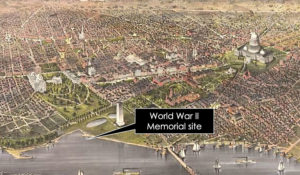By Tom King
Whatever else you can say about the World War II (WWII) Memorial on the National Mall, it’s surely obvious that its siting, on the filled-in marshland of the Potomac River, was questionable at best. It’s gotten more questionable as the effects of climate change have become apparent. As sea levels – and hence Chesapeake Bay levels, and hence Potomac estuary levels – rise, it must follow as the night the day that the position of the WWII Memorial becomes more and more precarious.

It is no surprise that, only 8 years after its dedication, the Memorial’s waterproofing slurry wall was leaking, and now the Memorial itself is cracking, and of course it floods rather regularly (most recently in 2019). The National Park Service (NPS) assures the world that the Memorial’s structural integrity is not yet in danger, and perhaps this is true, but it is hardly believable that it will be true much longer. It certainly appears that repairs are underway on the Memorial almost continually. The Memorial’s geological and geographic context makes it predictable that in the not-too-distant future it will simply become too expensive for NPS to maintain – if it doesn’t obviate its own maintenance problems by collapsing into the buried swamp.
So what’s to do? Keep finding ever more creative (and costly) ways to prop the thing up, repair its leaks and cracks, reinforce its underpinnings? Or rethink the whole business?
Twenty years ago, the National Mall Coalition was formed in the heat of the fight over the WWII Memorial. The Coalition, with a number of allies, objected both to its siting over the western part of the Reflecting Pool and to its design – evocative as it is of Fascist stripped classicism and ignorant as it seems of America’s allies, many of whom preceded us into the fight. The Coalition lost, big-time, when Congress responded to constituent pressure by directing that the thing be built, at the selected site, according to the selected design (For details, see our Historical Timeline).
But time and tide do not respect even the pronouncements of Congress. It is simply inevitable that the WWII Memorial will fall – maybe not next year, but probably before many decades pass. And before it falls – perhaps – NPS will have either to ask Congress for a humongous amount of money to keep the thing afloat, or acknowledge that it was a dumb plan in the first place and seek funding to…
Well, to do what? There’s no use crying over spoilt monuments; what can be done that’s positive?
How about starting to plan now for the WWII Memorial’s replacement? Learning lessons from the inapt siting and objectionable symbolism of the existing memorial, and trying to come up with something that will commemorate the triumph of the U.S. and its allies in a way that’s sustainable?
Responses?
• Thomas F. King PhD is an advisor to the National Mall Coalition. Email him at tomking106@gmail.com.
Tags: WWII Memorial
